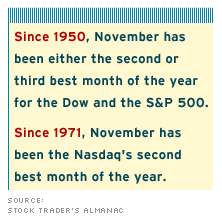NEW YORK (CNN/Money) -
November is typically a pretty bang-up month for the market. It's the start of the strongest six months of the year for stocks, and along with December and January, is typically one of the market's three best months. But don't get out the sparklers just yet.
This November is unlikely to be a downer, analysts say, but after the extraordinary run stocks have had this year, the month may seem a bit anti-climactic.
"I'm not expecting this November to be any different than it normally is, but it's unlikely we'll see the pace of growth we saw over the last few years," said Jeffrey Hirsch, editor of the Stock Trader's Almanac.

According to the Almanac, for the last half century, the Dow and the S&P 500 have on average gained about 1.4 percent in November, and the Nasdaq has averaged a gain of about 1.9 percent since its inception in 1971.
The Dow climbed eight out of the last 10 years in November. The S&P 500 and the Nasdaq advanced in seven of the last 10 Novembers. There were a couple misses in the early 1990's and then a big miss in 2000, when the aftermath of the 1990s' bull market took its toll on stocks as the country nail-bit its way through the first undecided presidential election since 1888.
But 2001 and 2002 marked a return to the good old days of November rallies, if not the bull market. Although stocks posted declines in both years, November was a doozy, with the major indexes carving out strong gains.
But in both those years, there was plenty of incentive to buy in November. Flat to weak summers led into horrific Septembers and then a super-strong 1-2-3 punch of October, November, December.
This year doesn't have a similar set up. The summer was pretty good for stocks, September was flat, and October started off with a bang and seems to be ending with a whimper.
"Stocks are up so much this year, and October hasn't been as bad as it often is," said Michelle Clayman, chief investment officer at New Amsterdam Partners. "Because of this, you might not see as much strength in November as usual. But the trend overall remains to the upside. I would expect stocks to move in fits and starts, but to end up marginally higher than they are now by the end of the year."
Too much of a good thing?
Some analysts are concerned that stocks are overbought this year and that a steeper pullback could be on tap. Year-to-date, the Nasdaq is up nearly 45 percent, the Dow is up almost 17 percent and the S&P 500 is up 19 percent, as of Tuesday's close.
The counter-argument says there are enough stimulative factors in the market to enable the major indexes to mostly hold their gains by year-end, if not to rally much.

"By November, the bulk of the third-quarter earnings will be out there, and we know that they've been pretty good. But for stocks to go higher, we're going to need another catalyst," said Donald Selkin, director of research at Joseph Stevens. "Expectations for a strong fourth quarter could do it, positive comments on the holiday season could do it, but really, I think it's going to be the economic news."
Third-quarter earnings have so far been stronger than expected. To date, roughly 68 percent of the S&P 500 have reported and on average, earnings are up 22 percent from last year, according to First Call. However, the improved reports haven't had much impact on stock prices, and some analysts say strong earnings have already been priced into the market.
"I think that the first two weeks of November will be wishy-washy, as we continue to trade in this range we've been in recently that started with the earnings, but as investors digest the month's economic news, which should be positive, we'll be able to move higher again," said Peter Cardillo, director of research at Global Partners Securities.
Economic reports have been making a case for strong growth. That's been supported recently by a number of multibillion-dollar mergers in the banking and insurance sectors. On Tuesday, the Federal Reserve opted to keep the federal funds rate steady at a 42-year low of 1 percent and indicated it would keep it there for the foreseeable future.
The October employment report, due next week, will be particularly important, analysts said. Economists surveyed by Briefing.com are expecting the unemployment rate to hold steady at 6.1 percent and for employers to have added 50,000 jobs to their payrolls.
"If we show a build on the slight improvement in the labor market we've seen, if the economy continues to grow, there will be a decent November," Selkin said.
The Almanac's Hirsch says it's reasonable to project that the major indexes could each gain around 1.5 percent to 2 percent in the month, in line with historical trends.
But then comes December, which, if historic precedent means anything, should bring the best month of the year for the S&P 500 and the second best for the Dow and Nasdaq.

|

